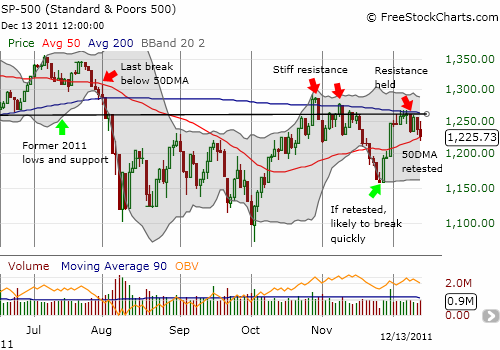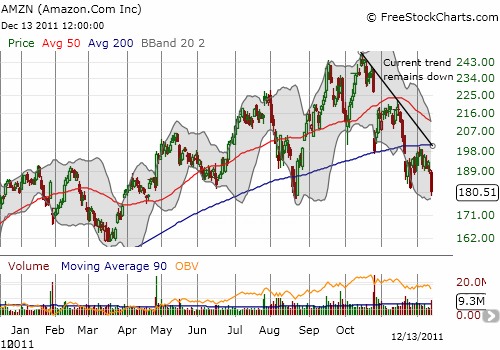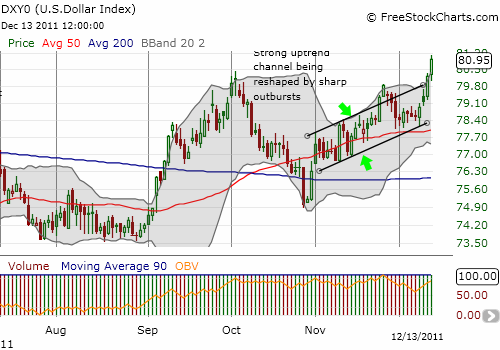(T2108 measures the percentage of stocks trading above their respective 40-day moving averages [DMAs]. To learn more about it, see my T2108 Resource Page. You can follow real-time T2108 commentary on twitter using the #T2108 hashtag. T2108-related trades and other trades are posted on twitter using the #120trade hashtag)
T2108 Status: 35%
VIX Status: 26
General (Short-term) Trading Call: Hold
Commentary
Since Wednesday, T2108 has gone from 67% to 44% to 59% to 45% and now 35%. Until today’s action, I was thinking the market’s yo-yo bouncing was validating my expectation for an unexciting and non-tradeable end of the year. When T2108 bounces between 40% and 60%, we learn very little about the market’s behavior or direction. The breakdown to 35% validates my preference to stay bearish even as T2108 could not quite break into overbought territory.
The S&P 500 only fell 0.9% but the selling felt worse than the closing price suggests. The index initially rallied in the morning in an attempt to yo-yo its way into recovering yesterday’s losses despite the euro’s increasing weakness. It was not until the Federal Reserve released its latest monetary policy statement that the selling really picked up steam. I will digress into fundamentals here to say that I believe the biggest issue is that the Federal Reserve provided further, and likely final, confirmation to market participants that the on-going sovereign debt crisis in Europe is a serious risk to economic growth. Related stern warnings have been issued by central banks in the United Kingdom, Australia, and Canada; traders and investors in the U.S. have behaved generally hopeful through it all.
The chart below shows the current technical setup on the S&P 500. Note that the 50DMA has been tested for two days in a row. This line of support/resistance has served as a mere speed bump the last two trips. I think this time will be no different.

I spent a lot of time tweeting yesterday and today, providing a good summary of my bearish bias. On Monday I was alarmed by very deep sell-offs in certain commodity and cyclical stocks. Intel’s (INTC) warning helped bring the NASDAQ down on Monday, but it was Amazon.com (AMZN) that caught closer scrutiny from me in techland.
AMZN is now on its 17th day trading below its 200DMA. When it first broke down below this critical support, I tweeted that I expected AMZN to spend longer below the 200DMA than on its previous trip in August. While I nailed that prediction, I would have expected AMZN to be at much lower prices after so many days below support. Today’s 4.8% sell-off created a very bearish continuation pattern that presages even lower prices “soon.” I decided to sell my puts into the selling, preferring to get back in after an obligatory bounce back, relief rally. Regardless, I consider AMZN’s bearish chart to be very ominous given its bellwether status as a strong momentum stock that supposedly represents the health of retail. (This also means I need to brace myself in the Best Buy (BBY) position I re-initiated after the steep post-earnings sell-off. The stock remains within the widening trading range I have noted in previous posts.)

In other trades, I finally closed out my long-standing short against the euro in EUR/USD. Throughout the euro’s steady decline, I have warned and warned again that the currency’s behavior has remained bearish. It was an interesting experience noticing how intraday behavior revealed the true, underlying sentiment even as the daily chart appeared relatively tame. The euro’s 2-day plunge this week has helped the dollar index surge through the upward trend channel in even greater force than the 2-day surge sandwiching Thanksgiving.

Going forward I intend to trade against the euro by fading rallies and holding for much shorter periods of time. The euro is going to drop ever lower, but the volatility on the way there should provide better trades for lower risk than trying to hold on for the euro’s ultimate destination.
Finally, the VIX really threw me for a loop today. The volatility index finally broke down below its 200DMA, the first time since the day before its 2-week run into the August swoon. I assumed this confirmed the market’s stubborn complacency over the dropping euro. I decided to get bearish on VXX, the iPath S&P 500 VIX Short-Term Futures, and I bought January puts. The VIX proceeded to recover and closed the day a sliver below the 200DMA. The key signal will be the VIX’s follow-through (or lack thereof). In the meantime, I will not complain if my expiring December VXX calls deliver profits this week.
Charts below are the latest snapshots of T2108 (and the S&P 500)
Refresh browser if the charts are the same as the last T2108 update.
Black line: T2108 (measured on the right); Green line: S&P 500 (for comparative purposes)
Weekly T2108

*All charts created using freestockcharts.com unless otherwise stated
Related links:
The T2108 Resource Page
Expanded daily chart of T2108 versus the S&P 500
Expanded weekly chart of T2108
Be careful out there!
Full disclosure: long SDS and VXX; long VXX calls and puts; net long U.S. dollar; net short euro, long BBY

